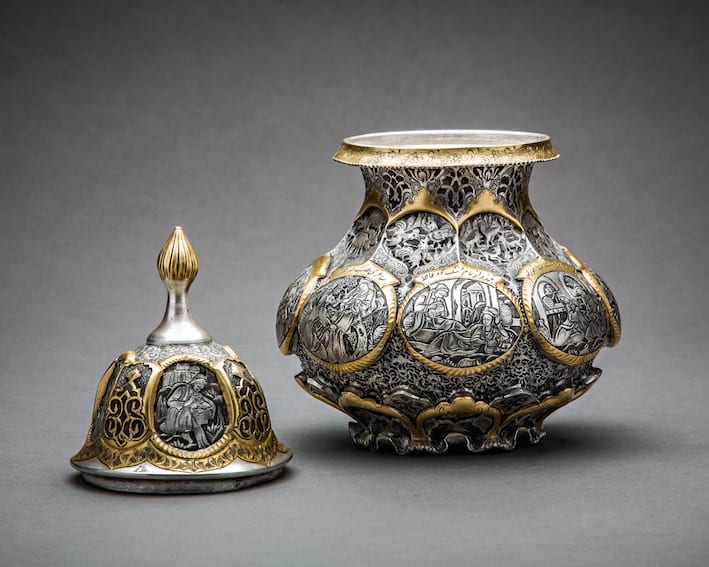Silver gold inlaid lidded Qajar urn, 1800 BCE - 1900 CE
22.9 x 12.7 x 12.7 cm
9 x 5 x 5 in
9 x 5 x 5 in
MS.1746
Further images
'Qajar' and 'Qajars' redirect here. For other uses, see Qajar (disambiguation). Sublime State of Persi ???? ????? ????? Dolate Eliyye Ira 1789–1925 Fla Flag of Persi Coat of arm Coat...
"Qajar" and "Qajars" redirect here. For other uses, see Qajar (disambiguation).
Sublime State of Persi ???? ????? ?????
Dolate Eliyye Ira 1789–1925 Fla Flag of Persi Coat of arm Coat of arm Anthe Salâm-e Shâ (Royal salute)
MENU0:0 Map of Iran under the Qajar dynasty in the 19th century.
Capital Tehra Languages Persian (court literature/language, administrative, cultural, official),[1][2]
Azerbaijani (court language and mother tongue)[3]
[4]
Government Absolute monarchy (1785–1906)
Constitutional monarchy (1906–1925)
Shahanshah • 1794–1797 Mohammad Khan Qajar (first)
• 1909–1925 Ahmad Shah Qajar (last)
Prime Minister • 1906 Mirza Nasrullah Khan (first)
• 1923–1925 Reza Pahlavi (last)
History • Qajar dynasty begins 178 • Treaty of Gulistan 24 October 181 • Treaty of Turkmenchay 10 February 182 • Treaty of Paris 4 March 185 • Treaty of Akhal 21 September 188 • Persian Constitutional Revolution 5 August 190 • Pahlavi dynasty begins 192 Currency qiran[5]
Preceded by Succeeded b Zand dynast Kingdom of Kartli-Kakhet Afsharid dynast Pahlavi dynasty Russian Empire Today part of Countries[show]
Part of a series on th History of Ira Persepolis 24.11.2009 11-12-14.jp Mythological history[show]
Ancient period[show]
Imperial period[show]
Medieval period[show]
Early modern period[show]
Modern period[show]
Related articles[show]
Timelin Flag of Iran.svg Iran porta v t The Qajar dynasty (About this sound listen (help·info); Persian: ????? ?????? Selsele-ye Qajar; also Romanised as Ghajar, Kadjar, Qachar etc.; Azerbaijani: ???????? Qacarlar) was an Iranian[6] royal dynasty of Turkic origin,[7][8][9][10] specifically from the Qajar tribe, which ruled Persia (Iran) from 1785 to 1925.[11][12] The state ruled by the dynasty was officially known as the Sublime State of Persia (Persian: ???? ????? ?????? Dolate Aliyye Iran). The Qajar family took full control of Iran in 1794, deposing Lotf 'Ali Khan, the last Shah of the Zand dynasty, and re-asserted Iranian sovereignty over large parts of the Caucasus. In 1796, Mohammad Khan Qajar seized Mashhad with ease,[13] putting an end to the Afsharid dynasty, and Mohammad Khan was formally crowned as shah after his punitive campaign against Iran's Georgian subjects.[14] In the Caucasus, the Qajar dynasty permanently lost many of Iran's integral areas[15] to the Russians over the course of the 19th century, comprising modern-day Georgia, Dagestan, Azerbaijan and Armenia.[16]
Sublime State of Persi ???? ????? ?????
Dolate Eliyye Ira 1789–1925 Fla Flag of Persi Coat of arm Coat of arm Anthe Salâm-e Shâ (Royal salute)
MENU0:0 Map of Iran under the Qajar dynasty in the 19th century.
Capital Tehra Languages Persian (court literature/language, administrative, cultural, official),[1][2]
Azerbaijani (court language and mother tongue)[3]
[4]
Government Absolute monarchy (1785–1906)
Constitutional monarchy (1906–1925)
Shahanshah • 1794–1797 Mohammad Khan Qajar (first)
• 1909–1925 Ahmad Shah Qajar (last)
Prime Minister • 1906 Mirza Nasrullah Khan (first)
• 1923–1925 Reza Pahlavi (last)
History • Qajar dynasty begins 178 • Treaty of Gulistan 24 October 181 • Treaty of Turkmenchay 10 February 182 • Treaty of Paris 4 March 185 • Treaty of Akhal 21 September 188 • Persian Constitutional Revolution 5 August 190 • Pahlavi dynasty begins 192 Currency qiran[5]
Preceded by Succeeded b Zand dynast Kingdom of Kartli-Kakhet Afsharid dynast Pahlavi dynasty Russian Empire Today part of Countries[show]
Part of a series on th History of Ira Persepolis 24.11.2009 11-12-14.jp Mythological history[show]
Ancient period[show]
Imperial period[show]
Medieval period[show]
Early modern period[show]
Modern period[show]
Related articles[show]
Timelin Flag of Iran.svg Iran porta v t The Qajar dynasty (About this sound listen (help·info); Persian: ????? ?????? Selsele-ye Qajar; also Romanised as Ghajar, Kadjar, Qachar etc.; Azerbaijani: ???????? Qacarlar) was an Iranian[6] royal dynasty of Turkic origin,[7][8][9][10] specifically from the Qajar tribe, which ruled Persia (Iran) from 1785 to 1925.[11][12] The state ruled by the dynasty was officially known as the Sublime State of Persia (Persian: ???? ????? ?????? Dolate Aliyye Iran). The Qajar family took full control of Iran in 1794, deposing Lotf 'Ali Khan, the last Shah of the Zand dynasty, and re-asserted Iranian sovereignty over large parts of the Caucasus. In 1796, Mohammad Khan Qajar seized Mashhad with ease,[13] putting an end to the Afsharid dynasty, and Mohammad Khan was formally crowned as shah after his punitive campaign against Iran's Georgian subjects.[14] In the Caucasus, the Qajar dynasty permanently lost many of Iran's integral areas[15] to the Russians over the course of the 19th century, comprising modern-day Georgia, Dagestan, Azerbaijan and Armenia.[16]







